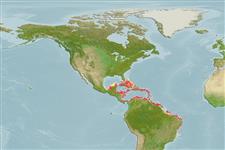Actinopterygii (ray-finned fishes) >
Perciformes (Perch-likes) >
Serranidae (Sea basses: groupers and fairy basslets) > Serraninae
Etymology: Paralabrax: Greek, para = the side of + Greek, labrax, -akos = a fish, Dicentrarchus labrax (Ref. 45335).
Environment / Climate / Range
Ecology
Marine; brackish; reef-associated; depth range ? - 50 m (Ref. 5217). Tropical, preferred ?
Western Atlantic: northern coast of South America.
Size / Weight / Age
Maturity: Lm ? range ? - ? cm
Max length : 43.0 cm TL male/unsexed; (Ref. 5217); common length : 35.0 cm TL male/unsexed; (Ref. 5217); max. published weight: 1.3 kg (Ref. 5217)
Dorsal
spines
(total): 10;
Dorsal
soft rays
(total): 14;
Anal
spines: 3;
Anal
soft rays: 7. Body brown, yellowish brown ventrally; 7 vertical dark brown bars on ventral part of body; a large dark brown blotch edged with a pale yellowish brown line on pectoral base; pectoral, pelvic and anal fins dark brown (Ref. 13608).
Found on semi-hard or soft bottoms. Juveniles are often in association with Thalassia. Synchronously hermaphroditic (Ref. 7251).
Life cycle and mating behavior
Maturity | Reproduction | Spawning | Eggs | Fecundity | Larvae
Cervigón, F., R. Cipriani, W. Fischer, L. Garibaldi, M. Hendrickx, A.J. Lemus, R. Márquez, J.M. Poutiers, G. Robaina and B. Rodriguez, 1992. Fichas FAO de identificación de especies para los fines de la pesca. Guía de campo de las especies comerciales marinas y de aquas salobres de la costa septentrional de Sur América. FAO, Rome. 513 p. Preparado con el financiamento de la Comisión de Comunidades Europeas y de NORAD. (Ref. 5217)
IUCN Red List Status (Ref. 115185)
CITES (Ref. 94142)
Not Evaluated
Threat to humans
Harmless
Human uses
Fisheries: commercial
More information
Common namesSynonymsMetabolismPredatorsEcotoxicologyReproductionMaturitySpawningFecundityEggsEgg development
ReferencesAquacultureAquaculture profileStrainsGeneticsAllele frequenciesHeritabilityDiseasesProcessingMass conversion
Tools
Special reports
Download XML
Internet sources
Estimates of some properties based on models
Phylogenetic diversity index (Ref.
82805): PD
50 = 0.5020 [Uniqueness, from 0.5 = low to 2.0 = high].
Bayesian length-weight: a=0.01096 (0.00528 - 0.02278), b=3.06 (2.89 - 3.23), in cm Total Length, based on LWR estimates for this (Sub)family-body shape (Ref.
93245).
Trophic Level (Ref.
69278): 4.0 ±0.5 se; Based on size and trophs of closest relatives
Resilience (Ref.
69278): Medium, minimum population doubling time 1.4 - 4.4 years (Preliminary K or Fecundity.).
Vulnerability (Ref.
59153): Moderate vulnerability (38 of 100) .
